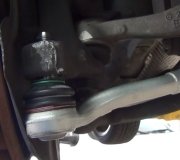Head back to the shop that did the alignment. Without seeing it, I can think of two things that could cause this. One is that strut is fully-extended and became locked that way. Setting up most alignment equipment requires all four tires to be raised up off the hoist as part of the calibration procedure. If the car is lifted by the frame, that allows the suspension to hang freely with the struts fully extended. I've had at least two that became locked over the years. One let go by just pushing on the car. One had to be driven around the parking lot before it released. In both cases I wrote notes to that effect on the repair order so the car owner was aware of it in case it ever happened to them again. Replacing the struts would solve that, but since this is such a rare occurrence, it's more common to just overlook it.
It's highly unlikely this would have happened on the alignment hoist because the specialist would have noticed it, but to add to the confusion, Ford engineers have been famous for leaving off one of the three most critical alignment adjustments to save on cost. That adjustment is for "camber". That is the inward or outward tilt of the wheel, as viewed from in front of the car. It has the biggest effect on which way the car pulls when you let go of the steering wheel, and too much camber either way accelerates tire wear on the inner or outer edges. If a strut had become locked fully extended and the alignment specialist didn't see that, it would cause camber to be out-of-specs on both sides. With any other car brand the mechanic would have tried to adjust it back into specs, and when it couldn't be done, he'd go looking for the reason, and he'd find the stuck strut. Fords are different. We all know that what you got is what you get, and when it's wrong, there's nothing we can do about it. Most of us just ignore the bad camber readings and move on with the rest of the alignment. If that strut releases later when you're driving the car, camber on both sides will go back to where it had been, and the only adjustment possible on this model will still be close enough to not cause a noticeable problem.
The strut should be inspected by the alignment specialist or the person who performed the repairs. It is also possible the strut's shaft was bent in the crash, and that is causing it to bind. That would be a better suspect than one that is sticking fully-extended. On cars with this type of strut, that shaft is the structural component that holds the wheel upright in alignment. During the alignment procedure, the car is sitting at normal ride height, and it's possible the bent part of the shaft is inside the strut's body. That means it would not adversely affect the camber reading at that time, so no one would have reason to suspect it has a problem. This type of bend doesn't have to be very significant to cause binding, and it might only be possible to identify after the strut is removed and disassembled.
The second thing to look for is only a suspect if the lower control arm was replaced by a do-it-yourselfer or an inexperienced mechanic with no formal training. The car has to be supported by the frame, either on a hoist or on jack stands, to replace a control arm. That means the suspension is hanging down. The new control arm will, of course, be hanging down the same way once it is installed. There's three attaching points for the arm on your car, and one of them is a common pivot bolt. It goes through a rubber bushing to reduce road shock. Where do-it-yourselfers cause trouble is they tighten that pivot bolt, complete the other repairs, then take the car for the alignment. Tightening that pivot bolt clamps the rubber bushing in that position. When the car is lowered onto the tires, the suspension parts move up as the car is lowered. That puts that bushing in a permanent twist which will greatly reduce its life. It's already under severe tension when the car is sitting still, then, when bouncing down the road, the tension on it intermittently goes a lot higher. It won't take long for the rubber to tear away from the metal sleeve, but before that happens, it can try to straighten out. To do that, it would try to go back to how it was installed; with the control arm hanging down, and the car body raised up. The clue here is there would still be some bounce in that corner, but that corner could be higher and stiffer than normal. The fix for this as long as it is caught before the bushing is damaged, and the proper installation procedure, is to leave that pivot bolt loose until the car is sitting on the tires at normal ride height. That can be on the ground or on the drive-on alignment hoist. That is when the pivot bolt must be tightened. From there, the bushing is designed to hold up to the normal range of travel the control arm goes through.
Thursday, March 14th, 2019 AT 5:25 PM


